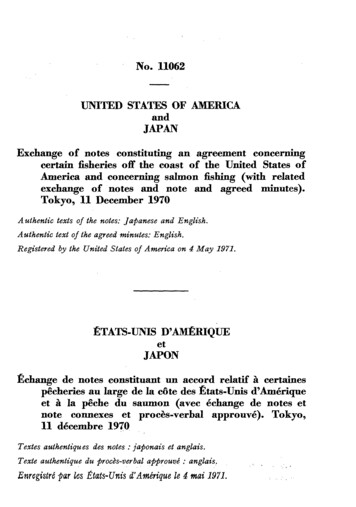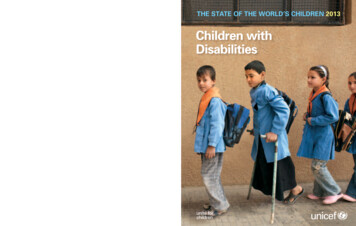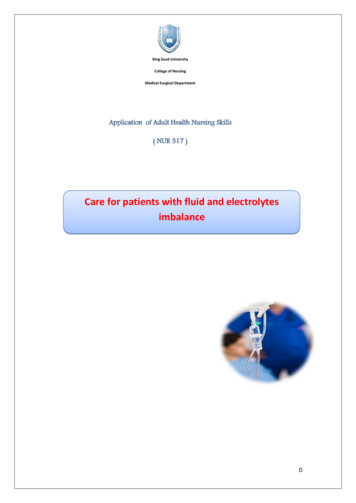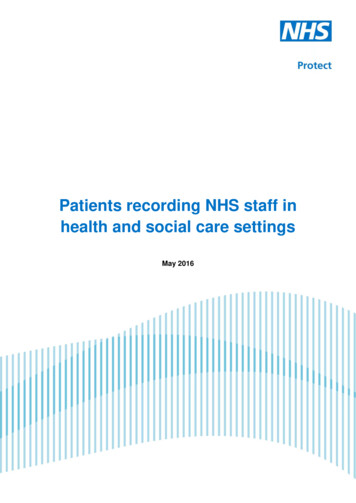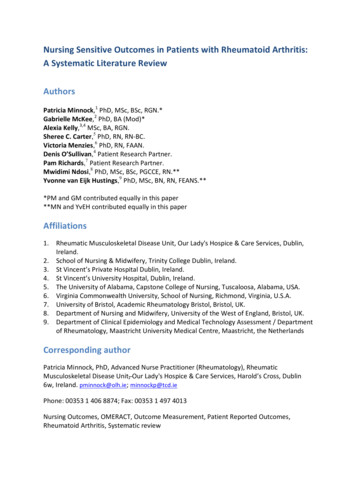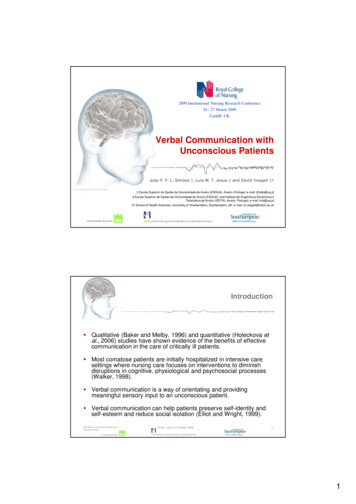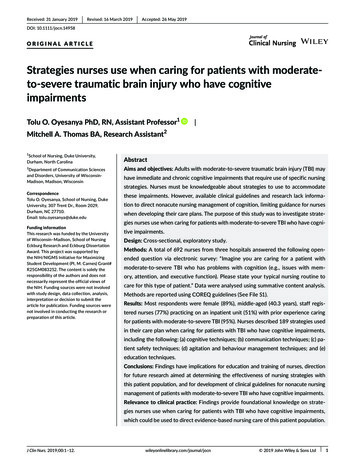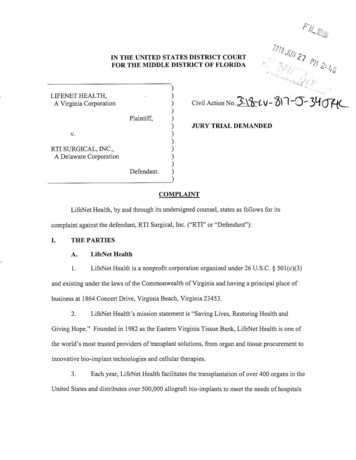
Transcription
and patients in the United States and internationally. An allograft is human donor tissue, such asskin, bone, tendon, or cardiovascular tissue, intended for transplantation in a human recipient.4.LifeNet Health is also extensively involved in promoting and facilitating tissuedonation and bio-implant tissues. For example, LifeNet Health’s Tissue Services Division isdedicated to training, educating, and maintaining relationships with more than 50 partners topromote tissue donation in their respective communities.5.LifeNet Health also established its Wound Management & SurgicalReconstruction franchise to ensure the processing and delivery of skin/dermal allograft bioimplants for U.S. and international trauma and burn centers.6.In addition, LifeNet Health’s Bio-Implants Division has pioneered technologiesrelated to all aspects of the allograft bio-implant production process, including disinfection,decellularization (the removal of cellular elements from an allograft bio-implant), fabrication,preservation, and sterilization.7.LifeNet Health is also a member of several organizations related to tissuedonation. For example, LifeNet Health is an accredited member of the American Association ofTissue Banks, and also a member organization of Donate Life America, a not-for-profit allianceof national organizations across the United States committed to increasing organ, eye, and tissuedonation.8.The patents asserted by LifeNet Health in this Complaint are a result of LifeNetHealth’s extensive research and development in the field of tissue and bio-implant technology.B.RTI Surgical, Inc.9.Upon information and belief, RTI is a corporation organized and existing underthe laws of the State of Delaware and has a principal place of business at 11621 Research Circle,-2-
Alachua, FL 32615. RTI also has a regular and established place of business in this judicialdistrict at 13901 Sutton Park Drive South, Suite 350C, Jacksonville, Florida 32224.10.RTI is in the business of importing, manufacturing, selling, and/or offering forsale various medical products including skin/dermal products under the brand name Fortiva (“Fortiva”). RTI is also in the business of manufacturing, selling, and/or offering for sale variousbone products including Capistrano Cervical Allograft Spacer System (“Capistrano”), Puros-S2cervical (“Puros-S2”), AlloQuent-S (“AlloQuent”), CeSpace Cortical Cancellous Bone(“CeSpace”), Cornerstone ASR-Cortical Cancellous Block (“Cornerstone ASR”), and ElemaxCortical Cancellous Spacer (“Elemax”).11.Upon information and belief, Fortiva is a porcine (pig) skin xenograft (the“Infringing Soft Tissue Product”).12.Upon information and belief, Capistrano, Puros-S2, AlloQuent, CeSpace,Cornerstone ASR, and Elemax are allograft spine products (the “Infringing Bone Products”).II.JURISDICTION AND VENUE13.This action is a claim for patent infringement arising under the Patent Laws of theUnites States, 35 U.S.C. § 271 et seq.14.This Court has subject matter jurisdiction over this action pursuant to 28 U.S.C.§§ 1331, 1332, and 1338(a).15.This Court has personal jurisdiction over RTI at least because RTI has substantial,continuing, and on-going contacts within the State of Florida and this judicial district, and RTIhas sold and continues to sell the products at issue in this case in this State and judicial district.16.Venue is proper in this judicial district pursuant to 28 U.S.C. §§ 1391(b) and1400(b) at least because RTI has a regular and established place of business in this judicialdistrict. In addition, on information and belief, RTI has committed acts of infringement in the-3-
State of Florida and in this judicial district, including but not limited to offering to sell andselling products that infringe one or more of LifeNet Health’s asserted patents to customerslocated in this judicial district or for use in this judicial district.III.FACTSA.U.S. Patent No. 6,569,20017.On June 5, 2001, U.S. Patent Application No. 09/874,862 (the “’862 application”)was filed on behalf of inventors Lloyd Wolfinbarger, Jr., Robert K. O’Leary, and Billy G.Anderson. The ’862 Application is a divisional application of U.S. Patent Application No.09/107,459, filed June 30, 1998, now U.S. Patent No. 6,293,970 (the “ʼ970 patent”).18.On May 27, 2003, the U.S. Patent and Trademark Office (“USPTO”) issued the’862 application as U.S. Patent No. 6,569,200 (the “’200 patent”). A copy of the ’200 patent isattached as Exhibit A.19.LifeNet Health is the assignee of all right, title, and interest in and to the ’200patent and possesses all rights of recovery under the ’200 patent.20.The ’200 patent is directed to, inter alia, “plasticized dehydrated or freeze-driedbone and/or soft tissue product[s] that do[] not require special conditions of storage,” andmethods for producing the same. See Exhibit A at Abstract.21.As stated in the Abstract of the ’200 patent, “[t]he invention replaces water in themolecular structure of the bone or soft tissue matrix with one or more plasticizers allowing fordehydration of the tissue, yet not resulting in an increase in brittleness of the plasticized product,and resulting in compressive and/or tensile properties similar to those of normal hydrated bone.Replacement of the chemical plasticizers by water prior to implantation is not required and thus,the dehydrated bone or soft tissue plasticized product can be placed directly into an implant sitewithout significant preparation in the operating room.” Id.-4-
22.In 2010, with the launch of its Oracell dermal implant, LifeNet introducedPreservon grafts, processed using its proprietary bio-implant tissue-preservation technologybased on the ’200 patent family. This technology is an ambient temperature (room temperature)preservation method that simplifies the tissue-preparation and product-distribution processes andstorage, saves valuable time in the operating room, and allows allograft tissue to retain itsphysical and biomechanical properties.23.Starting in 2010 with the launch of its Oracell dermal implant, LifeNet hasmarked its products incorporating the proprietary bio-implant tissue-preservation technologywith the ʼ200 patent number.B.U.S. Patent No. 9,579,42024.On February 8, 2010, U.S. Patent Application No. 12/701,634 (the “’634application”) was filed on behalf of inventors Lloyd Wolfinbarger, Jr., Robert K. O’Leary, andBilly G. Anderson (deceased) by plaintiff LifeNet Health.25.On February 28, 2017, the USPTO issued the ’634 application as U.S. Patent No.9,579,420 (the “’420 patent”). A copy of the ’420 patent is attached as Exhibit B.26.The ’420 patent claims priority through a series of applications to the ’970 patent.27.LifeNet Health is the assignee of all right, title, and interest in and to the ’420patent and possesses all rights of recovery under the ’420 patent.28.The ’420 patent is one of several issued patents in the ’970 patent family.29.The invention of the ’420 patent is also directed to, inter alia, “plasticizeddehydrated or freeze-dried bone and/or soft tissue product[s] that do[] not require specialconditions of storage,” and methods for producing the same. See Exhibit B at Abstract.-5-
C.U.S. Patent No. 9,585,98630.On February 28, 2014, U.S. Patent Application No. 14/193,040 (the “’040application”) was filed on behalf of inventors Lloyd Wolfinbarger, Jr., Robert K. O’Leary, andBilly G. Anderson (deceased) by plaintiff LifeNet Health.31.On March 7, 2017, the USPTO issued the ’040 application as U.S. Patent No.9,585,986 (the “’986 patent”). A copy of the ʼ986 patent is attached as Exhibit C.32.The ’986 patent claims priority through a series of applications to the ’970 patent.33.LifeNet Health is the assignee of all right, title, and interest in and to the ’986patent and possesses all rights of recovery under the ’986 patent.34.The ’986 patent is one of several issued patents in the ’970 patent family.35.The invention of the ’986 patent is also directed to, inter alia, “plasticizeddehydrated or freeze-dried bone and/or soft tissue product[s] that do[] not require specialconditions of storage,” and methods for producing the same. See Exhibit C at Abstract.D.U.S. Patent No. 6,458,15836.On October 27, 2000, U.S. Patent Application No. 09/699,029 (the “’029application”) was filed on behalf of inventors Billy G. Anderson and Lloyd Wolfinbarger, Jr.37.On October 1, 2002, the USPTO issued the ʼ029 application as U.S. Patent No.6,458,158 (the “’158 patent”). A copy of the ʼ158 patent is attached as Exhibit D.38.The ’158 patent is a continuation-in-part of U.S. Patent Application No.09/286,975 (the “’975 application), filed on April 6, 1999, now abandoned. The ʼ975 applicationis a continuation-in-part of U.S. Patent Application No. 09/225,299 (the “’299 application”),filed on January 5, 1999, now abandoned.39.LifeNet Health is the assignee of all right, title, and interest in and to the ’158patent and possesses all rights of recovery under the ’158 patent.-6-
40.The invention of the ’158 patent is directed to “a composite bone graft forimplantation in a patient.” See Exhibit D at Abstract.E.U.S. Patent No. 8,182,53241.On September 30, 2004, U.S. Patent Application No. 10/953,881 (the “’881application”) was filed on behalf of inventors Billy G. Anderson (deceased) and LloydWolfinbarger, Jr.42.On May 22, 2012, the USPTO issued the ʼ881 application as U.S. Patent No.8,182,532 (the “’532 patent”). A copy of the ’532 patent is attached as Exhibit E.43.The ’532 patent claims priority through a series of applications to both the ’975application and the ’299 application.44.LifeNet Health is the assignee of all right, title, and interest in and to the ’532patent and possesses all rights of recovery under the ’532 patent.45.The invention of the ’532 patent is also directed to “a composite bone graft forimplantation in a patient.” See Exhibit E at Abstract.F.Prior Litigation Regarding the ’200 Patent46.In September 2013, LifeNet Health filed suit in the U.S. District Court for theEastern District of Virginia asserting infringement of the ’200 patent by LifeCell Corporation(“LifeCell”). See D.I. 1, Civil Action No. 2:13-cv-00486, September 6, 2013 (E.D. Va.) (the“’200 patent litigation”). LifeNet Health accused LifeCell’s porcine Strattice product, amongothers, of infringing the ʼ200 patent.47.After a ten-day jury trial, the jury found the ’200 patent to be valid and infringedby Strattice and other LifeCell products, and awarded damages to LifeNet Health in the amountof 34,741,971. See ’200 patent litigation, D.I. 369, 395. The U.S. Court of Appeals for the-7-
Federal Circuit upheld the verdict in LifeNet Health’s favor on appeal in a unanimous paneldecision. See LifeNet Health v. LifeCell Corp., 837 F.3d 1316 (Fed. Cir. 2016).48.On information and belief, RTI had knowledge of the ʼ200 patent at least byvirtue of the ʼ200 patent litigation. On information and belief, RTI also had knowledge of thejury verdict and of the appellate decision of the ʼ200 patent litigation.G.RTI’s Infringing Soft Tissue Product49.Upon information and belief, RTI has been using, importing, manufacturing,selling, and/or offering for sale a porcine dermis tissue product under the brand name Fortiva.50.RTI filed papers at the U.S. Food and Drug Administration (“FDA”) andrepresented to the FDA that Fortiva “is substantially equivalent to the predicate device Strattice (K070560) in intended use, material, design, and function.” RTI March 5, 2013 510(k)Summary (“RTI 510(k)”) (attached as Exhibit F) at 1. As discussed above, in the ’200 patentlitigation, Strattice was found to infringe claims 1-4, 7, 8, and 10 of the ’200 patent, and thisfinding of infringement was upheld on appeal.51.RTI makes a number of other claims about Fortiva in its FDA filings and in theInstructions for Use (“IFU”) for Fortiva:52.“Fortiva porcine dermis is an extracellular collagen matrix comprised ofporcine dermal tissue that has been processed and terminally sterilized via gamma irradiation.The surgical mesh device is designed to perform as a scaffold that allows for neovascularizationand permits replacement of the device with patient’s tissue. The sterile device is supplied prehydrated in water and is provided in various sizes. The device is ready for immediate usewithout extra preparation (i.e., no rinsing, no soaking, etc.)” Fortiva IFU (attached as Exhibit G)at 2.-8-
53.“This device is processed via the Tutoplast tissue sterilization process whichincludes meticulous cleaning and solvent dehydration of the tissue. The process inactivates orremoves potential pathogens, gently removes unwanted materials, such as cells, antigens andviruses. As part of the Tutoplast process, this device was terminally sterilized by gammairradiation to a sterility assurance level (SAL) of 10-6. The sterilization validation methodemployed meets or exceeds requirements of the Association for the Advancement of MedicalInstrumentation (AAMI) and International Organization for Standards (ISO).” Fortiva IFU,Exhibit G, at 2.54.“The device is shipped at ambient temperature via expedited shipping methods.Keep the device in a clean, dry place between 10 C and 30 C and protected from direct sunexposure.” Fortiva IFU, Exhibit G, at 2.55.“The proposed device is an implantable surgical mesh comprised of non-crosslinked porcine dermis that has been processed, terminally sterilized and is stored hydratedand ready to use. The proposed device is designed to perform as a scaffold that allows forneovascularization and permits replacement of the device with host tissue.” RTI 510(k), ExhibitF, at 1.56.“This device is comprised of non-crosslinked porcine dermis that has beenprocessed, terminally sterilized and stored hydrated and ready to use. The device has the sametechnological characteristics as the predicate device [Strattice] in material, design, and functionas listed in the table below:-9-
.”RTI 510(k), Exhibit F at 2.57.Upon information and belief, in view of the fact that RTI declared to the FDA thatFortiva “is substantially equivalent to the predicate device Strattice ” and in view of at least theclaims made by RTI about Fortiva identified above, Fortiva meets each and every limitation ofclaims 1-4, 7, and 8 of the ʼ200 patent.58.Upon information and belief, and for those same reasons, Fortiva is a plasticizedsoft tissue graft suitable for transplantation into a human, as set forth in at least claims 1-4 of the’200 patent.59.Upon information and belief, Fortiva is a cleaned soft tissue graft having aninternal matrix, and one or more plasticizers contained in the internal matrix as set forth in claim1. See supra, paragraphs 52 (Fortiva is “an extracellular collagen matrix comprised of porcinedermal tissue that has been processed”); 53 (Fortiva is processed by a method “which includesmeticulous cleaning and solvent dehydration of the tissue.” The processing “removes potentialpathogens, gently removes unwanted materials, such as cells, antigens and viruses.”); 55 (Fortiva“is an implantable surgical mesh comprised of non-crosslinked porcine dermis that has beenprocessed, terminally sterilized and is stored hydrated and ready to use.”); 56 (Fortiva “has the- 10 -
same technological characteristics as the predicate device [Strattice] in material, design, andfunction.”).60.Upon information and belief, the one or more plasticizers in Fortiva are notremoved from the internal matrix of the plasticized soft tissue graft prior to transplantation into ahuman as set forth in claim 1. See supra, paragraphs 52 (Fortiva “is ready for immediate usewithout extra preparation (i.e., no rinsing, no soaking, etc.)”); 55 (Fortiva “is an implantablesurgical mesh comprised of non-crosslinked porcine dermis that has been processed, terminallysterilized and is stored hydrated and ready to use.”); 56 (Fortiva “has the same technologicalcharacteristics as the predicate device [Strattice] in material, design, and function.”).61.Upon information and belief, Fortiva is a plasticized soft tissue graft that issuitable for direct transplant into a human without rehydration, as set forth in claim 4. See supra,paragraphs 52 (Fortiva “is ready for immediate use without extra preparation (i.e., no rinsing, nosoaking, etc.)”); 56 (Fortiva “is stored hydrated and ready to use.”); 56 (Fortiva “has the sametechnological characteristics as the predicate device [Strattice] in material, design, andfunction.”).62.Upon information and belief, RTI has been manufacturing, or causing to bemanufactured, Fortiva, according to the method of claims 7 and 8 of the ’200 patent. Uponinformation and belief, Fortiva is manufactured by impregnating a cleaned, soft tissue graft withone or more plasticizers to produce a plasticized soft tissue graft, where the one or moreplasticizers are not removed from an internal matrix of the plasticized soft tissue graft prior totransplantation into a human as set forth in claim 7. See supra, paragraphs 52 (Fortiva “is readyfor immediate use without extra preparation (i.e., no rinsing, no soaking, etc.)”); 53 (Fortiva isprocessed through a method that results in “solvent dehydration of the tissue”); 55 (Fortiva “is an- 11 -
implantable surgical mesh comprised of non-crosslinked porcine dermis that has been processed,terminally sterilized and is stored hydrated and ready to use.”); 56 (Fortiva “has the sametechnological characteristics as the predicate device [Strattice] in material, design, andfunction.”).63.Upon information and belief, Fortiva is a plasticized soft tissue graft suitable fortransplantation into a human, as set forth in at least claims 1-4, 8, 9, 11, 13, and 14 of the ’420patent. Upon information and belief, Fortiva is a cleaned soft tissue graft having an internalmatrix, and one or more plasticizers contained in the internal matrix as set forth in claim 1. Seesupra, paragraphs 52 (Fortiva is “an extracellular collagen matrix comprised of porcine dermaltissue that has been processed”); 53 (Fortiva is processed “which includes meticulous cleaningand solvent dehydration of the tissue.” The processing “removes potential pathogens, gentlyremoves unwanted materials, such as cells, antigens and viruses.”); 55 (Fortiva “is animplantable surgical mesh comprised of non-crosslinked porcine dermis that has been processed,terminally sterilized and is stored hydrated and ready to use.”); 56 (Fortiva “has the sametechnological characteristics as the predicate device [Strattice] in material, design, andfunction.”).64.Upon information and belief, Fortiva is a cleaned soft tissue graft comprisingcollagen fibers and the native orientation of the collagen fibers is maintained in the plasticizedsoft tissue graft as set forth in claim 1. See supra, paragraphs 52 (Fortiva is “an extracellularcollagen matrix comprised of porcine dermal tissue that has been processed”); 53 (the cleaningprocess of Fortiva “gently removes unwanted materials”); 56 (Fortiva “has the sametechnological characteristics as the predicate device [Strattice] in material, design, andfunction.”).- 12 -
65.Upon information and belief, Fortiva is a plasticized soft tissue graft that issuitable for direct transplant into a human without rehydration, as set forth in claim 4, is sterile,as set forth in claim 8, does not require refrigeration or freezing, as set forth in claim 9, and issuitable for storage at room temperature as set forth in claim 11. See supra, paragraphs 52, 55,56 (stating that Fortiva is supplied ready to use without extra preparation required); 52, 53, 55,56 (stating that Fortiva is sterilized); and paragraph 56 (stating that Fortiva is “shipped atambient temperature” and is to be stored “between 10 C and 30 C”).66.Upon information and belief, RTI has been manufacturing, or causing to bemanufactured, Fortiva, according to the method of claims 16-18, 28, 29, 34, and 35 of the ’420patent. Upon information and belief, Fortiva is manufactured by impregnating a cleane
RTI is in the business of importing, manufacturing, selling, and/or offering for sale various medical products including skin/dermal products under the brand name Fortiva (“Fortiva”). RTI is also in the business of manufacturing, selling, and/or offering for sale various . The ’200 patent is
